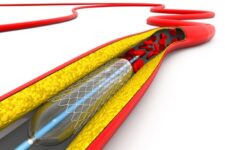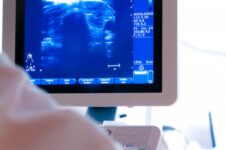Original title: Percutaneous treatment of adult isthmic aortic coarctation: acute and long-term clinical and imaging outcome with a self-expandable uncovered nitinol stent. Reference: Kische S et al. Circ Cardiovasc Interv. 2015 Jan;8(1). The aim of this study was to show perioperative and long term results of the percutaneous treatment of aortic coarctation with the self-expandable uncovered nitinol…
Frequency, indication and evolution of emergency cardiac surgery during TAVI
Original Title: Emergent cardiac surgery during transcatheter aortic valve implantation (TAVI): insight the Edwards SAPIENS Aortic Bioprosthesis Outcome (SOURCE) registry. Reference: Holger Eggerbrecht, et al. EuroIntervention 2014;10:975-81 SOURCE register data from patients receiving transcatheter aortic valve implantation with the Edwards Sapiens valve, were analyzed; out of 2307 patients, 27 (1.2%) required emergency cardiac surgery (ECS). Valve stenosis was…
Never ending controversy over the duration of post DES dual antiplatelet therapy
Original title: Second Generation Drug-Eluting Stents Implantation Followed by Six Versus Twelve-Month – Dual Antiplatelet Therapy- The SECURITY Randomized Clinical Trial. Reference: Antonio Colombo et al. J Am CollCardiol. 2014 Nov 18;64(20):2086-97. The optimal duration of dual antiplatelet therapy after second-generation DES implantation is still debated and apparently will remain controversial for some time. The aim of this…
Risks and benefits of Dual Antiplatelet beyond the year of a drug-eluting stent
Original title: Twelve or 30 Months of Dual Antiplatelet Therapy after Drug-Eluting Stents. Reference: Laura Mauri et al. N Engl J Med 2014;371:2155-66. Dual antiplatelet therapy is recommended after a drug-eluting stent to prevent thrombotic complications. The clinical benefit of this scheme it is not clear beyond one year. Patients were registered to receive a…
Promising results of TAVR in Bicuspid Aortic
Original title: Transcatheter Aortic Valve Replacement in Bicuspid Aortic Valve Disease. Reference: Darren Mylotte, et al. J Am Coll Cardiol 2014;64:2330-9 The bicuspid aortic valve (BAV) is present between 0.5% and 2% of the general population and up to 20% of patients older than 80 years who require aortic valve surgery. Literature on transcatheter aortic valve…
Third generation percutaneous aortic valve in intermediate-risk patients
Original title: Multicenter Evaluation of a Next-Generation Balloon-Expandable Transcatheter Aortic Valve. Reference: John Webb, et al. J Am Coll Cardiol 2014;64:2235-43 Percutaneous aortic valve replacement is starting to be a reasonable alternative in patients at intermediate risk. One hundred and fifty patients who received SAPIEN 3rd generation percutaneous aortic valve implantation were analyzed prospectively. The STS score of…
Long-term septal ablation in hypertrophic cardiomyopathy
Original title: Periprocedural Complication and Long-Term Outcome After Alcohol Septal ablation in hypertrofic Obstructive cardiomyopathy. A Single-Center Experience. Reference: Robbert Steggerda, et al. J Am Coll Cardiol Intv 2014;7:1227-34. Septal ablation is an alternative to surgery in hypertrophic cardiomyopathy (HCM), but indications and evolution are not fully established.161 patients who received septal ablation (SA) and 102 who received…
Stress echocardiography in low flow, low gradient aortic stenosis with deteriorated systolic function
Echocardiography Favaloro Foundation. Buenos Aires, Argentina. JACC Cardiovascular Imaging has recently published a retrospective analysis including severe aortic stenosis patients (< 1 cm²), with low gradient (mean aortic gradient Patients that had undergone dobutamine stress echocardiography (DSE) to distinguish pseudo aortic stenosis (n=49) were selected. These results were used to determine flow reserve (FR). The…
Hybrid Revascularization in Multiple Vessels
Original title: Hybrid Revascularization for Multivessel Coronary Artery Disease Reference: Mariuz Gassior, et al. J Am Cardiol Intv 2014;7:1277-83 According to the international guidelines, coronary artery bypass grafting (CABG) continues to be the “Gold Standard” treatment for multiple vessels diseases. However, second generation DES and the hybrid strategy may eventually change indications. This study randomized 102…
Thienopyridine Pretreatment in Non ST Elevation ACS syndrome
Original title: Reappraisal of thienopyridine pretreatment in patients with non-ST elevation acute coronary syndrome: a systematic review and meta-analysis. Reference: Bellemain-Appaix A. et al. BMJ. 2014;Epub ahead of print. This meta-analysis included 7 studies that included a total 32383 patients admitted with non ST elevation ACS; 17545 (54.5%) underwent PCI. These studies were published between 2001 and 2013:…









